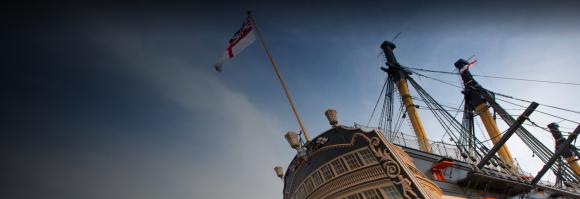 This week the BBC reported: Lord Nelson’s HMS Victory ‘collapsing’ under own weight. Sadly, this is not a new story. Five years ago we posted about an extremely similar account in the Telegraph: HMS Victory rotting and being pulled apart under its own weight. Last year we also posted: HMS Victory at 250 Years Old — Last Chance to Save the Historic Ship? The 250-year-old ship was never designed to sit high and dry in a drydock and is subject to rot and weathering like any wooden vessel.
This week the BBC reported: Lord Nelson’s HMS Victory ‘collapsing’ under own weight. Sadly, this is not a new story. Five years ago we posted about an extremely similar account in the Telegraph: HMS Victory rotting and being pulled apart under its own weight. Last year we also posted: HMS Victory at 250 Years Old — Last Chance to Save the Historic Ship? The 250-year-old ship was never designed to sit high and dry in a drydock and is subject to rot and weathering like any wooden vessel.
Fortunately, the problem is not being ignored. HMS Victory, Lord Nelson’s flagship in the Battle of Trafalgar in 1805, is undergoing a 13-year, £35m restoration. As part of the restoration, more than 130 metal supports are due to be fitted in the dry dock to stop the ship’s structure from deforming.
Andrew Baines, head of historic ships at the National Museum of the Royal Navy, explained, “‘The upper deck has been getting close to the keel at a rate that currently stands at around half a centimetre a year and as the upper deck moves down, the ship’s sides bulge out like squashing down on a football. The whole ship herself is falling very, very slowly backwards away from the bowsprit, the front end of the ship, and that was more or less all we knew back in March 2012.” He nevertheless was adamant that the ship could “absolutely be saved“.
There is also a significant problem with rain water leaking into the ship and causing rot. Baines also commented, “The most important thing for us to do is work on the ship’s structure to stop water getting in, stop the rot and stop us losing any more really valuable historical material in the ship.”
Thanks to David Rye for contributing to this post.

Any wooden boat is subject to shape deformation when out of water, even when well supported. Water is the natural element and a vessel is shaped and designed to be in water. However fresh water is a natural enemy of wood, and any slightly little crack, open seam or opening that allows fresh water in will eventually cause deterioration. Particularly in any climate where freezing (and expansion of ice opening up checks and cracks further) occurs. Baking hot sun doesn’t help either. Wooden boats, however, are infinitely renewable (witness the CHARLES W. MORGAN) and constant vigilance and maintenance, as well as keeping her tight, and supported (her natural buoyancy) in water will keep her reasonably sound. England needs to relaunch VICTORY for the long term. The amount of money (and time) projected for repairs and all is amazing!
Constitution (40 years younger) seems to thrive in a wet berth, not that she too doesn’t require regular attention over the decades.
My guess is that a wet berth is easier on the hull in general but age, water and wood are not natural allies. Hogging is still a big issue particularly in the case of the Constitution which is more slender than most frigates of her day. I remember seeing her before her 1990s restoration. She was hogged by over a foot. I have read that that in 1833 she has 30″ of hog before the Navy put her on the dock for repairs and that they nearly lost her before the 1925 restoration.
Pingback: Hull Repair For The HMS Victory | Shipmodelsuperstore's Blog